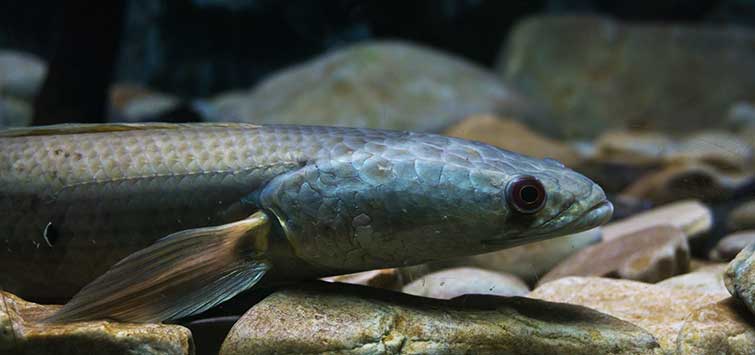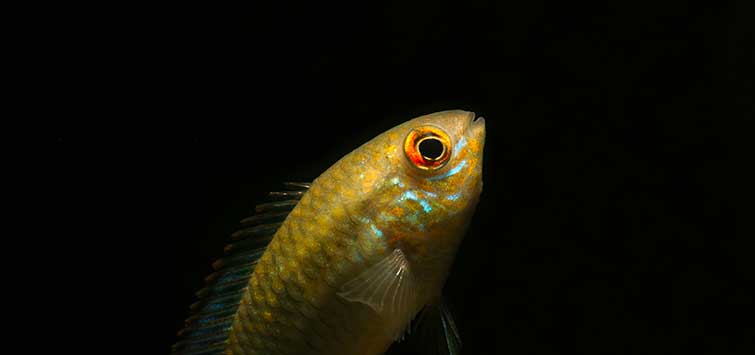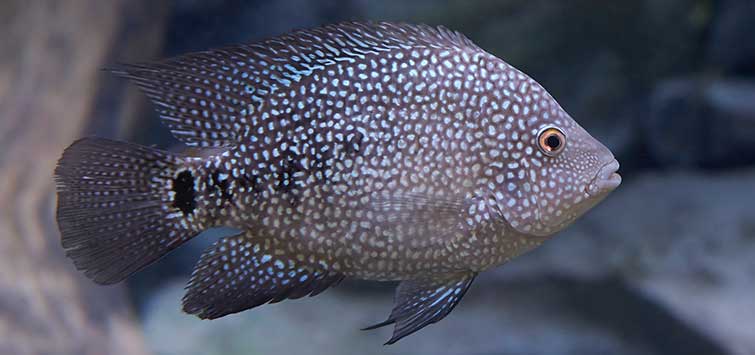Invasive Species and the Aquarist
Author: Tom Lorenz
The spread of invasive species throughout the world is a serious problem; understanding the issue and possible solutions is an important step toward saving the diversity and health of our planet.
Don’t Return Your Fish to the Environment
The threat of invasive species is one of the biggest concerns facing biodiversity on this planet. Being aquarists, we all appreciate biodiversity. After all, who among us has kept only one species of fish for their entire existence as a hobbyist? Our hobby has in it a wide variety of fish families, species, and even subspecies. And with these varieties comes a responsibility to make sure we can take care of these animals. Most of us would never even think of dumping our exotic pets into our native waters. However, some folks get confused and, while in this state of delusion, actually make this potentially devastating error.
Most people ignorant to this problem would argue that the fish couldn’t possibly survive and would just enjoy its freedom and then slowly pass away. Well, that’s wrong in many different ways. Typically a released fish will succumb to a variety of diseases before dying, and its odds of being eaten after fighting disease would be high as well. So it’s far from ethical even without any ecological impacts.
On a much larger scale, ecosystems don’t always react well to new species being introduced to them. And new species don’t always fare poorly in new environments—some actually thrive! Exotic species that survive often have negative impacts on native species. Even more relevant to the aquarist, lawmakers like to ban things that cause such problems. If the possible end result of an introduction is a disturbed ecosystem and the loss of availability of certain fishes, then we have a serious issue that all aquarists should be knowledgeable about. Oh yeah, there might be fines and even jail time to worry about too, depending on the species being introduced.
What Is an Invasive Species?
Invasive species are those that are introduced and then spread, often doing harm to the environment. Famous examples stand out: brown tree snakes Boiga irregularis eating the native birds of Guam, rabbits and cane toads running rampant in Australia, gypsy moths devouring trees, kudzu vines crawling over native vegetation in the south, and zebra mussels wiping out native mussels in the north. Similar examples that are even more worrisome would include West Nile Virus and AIDS being found in North America. The damage that is done ranges from extinctions to habitat loss to monetary loss to human deaths.
New species often fail, but when they succeed they can really take off. One example in particular looms in the minds of cichlid lovers, the ultimate aquarist tragedy of losing countless cichlid species to the introduced Nile perch in Lake Victoria.
Fish introductions have been particularly damaging. Game fish introduced outside of their ranges often eat species that have no evolutionary background for dealing with such predators. Sea lampreys have collapsed trout fisheries in the Great Lakes, causing millions of dollars in damage and even more money in researching and implementing solutions. Mosquitofish Gambusia affinis have been introduced all around the world to control mosquitoes, but they end up competing with native species that were eating the mosquitoes in the first place.
Who’s to Blame?
Agencies
You’re probably saying to yourself now, “but most of these truly tragic stories don’t involve hobbyists.” So what verified instances are there of aquarists impacting the environment? This is surprisingly hard to pin down. Many fish disasters are actually due to agencies instead of aquarists, including people in fisheries and aquaculture. Carp, tilapia, largemouth bass, bluegill, and Nile perch all seem like good things to introduce as new food sources (or for aquatic weed control with carp and some tilapia), until the ecosystem collapses and native species disappear.
Scientists and Aquarists
Even scientists have been responsible for introductions, including the pike killifish Belonesox belizanus, which was introduced into south Florida in the 1950s. Aquarists, however, were likely responsible for introductions of the pike killifish in central Florida and Texas.
Another scientist error involved the African clawed frogs Xenopus laevis. These frogs were very useful because the females laid eggs when exposed to urine from pregnant women. As I’m sure you know pregnancy tests are much easier now, and in the 1950s these frogs lost their usefulness and were dumped just like the pike killifish were. Unfortunately, California now has to deal with threats to native amphibians and fish because of these invasive frogs.
Hobbyists
Scientists, state agencies, and accidents aside, the hobby does have to shoulder some blame. Hobbyists have been implicated—rightly or falsely—in the introduction of snakeheads, goldfish, koi, lionfish, tilapia, various cichlids, walking catfish, guppies, Caulerpa, and other species. Goldfish and koi should be no surprise, considering their hardiness in cool weather and because they are often kept outside to begin with. But the multitudes of cichlids in the hobby also have several members that are doing quite well in Florida canals. Many of these seem restricted to the canals, but this should be no cause for relief. As we know, cichlids are evolutionary whiz kids and it only takes a couple of genetic changes to allow them to move into new habitats. The Mayan cichlid “Cichlasoma” urophthalmus has moved beyond the manmade structures of canals and is now found in natural areas and even marine conditions in south Florida.
The Everglades and Florida Bay now have a new species with unknown consequences ahead. My study species, the Rio Grande (Texas) cichlid Herichthys cyanoguttatus, has been found outside of the canals in New Orleans (although it is still plentiful within those canals). I remember one day catching one in a minnow trap and looking up to see the perfectly natural and beautiful cypress swamp where the trap was set. It was a slightly disturbing moment.
Snakeheads
And who can forget the snakeheads? News stories leaped off the pages with stories of Frankenstein fish that were crawling across land and eating everything and everyone in sight. Well of course they’re not that terrifying, but they are indeed voracious predators that have established themselves outside of their native range. They’re still being caught in natural habitats in Maryland (Channa argus), Florida (C. marulius), and Hawai`i (C. maculata). Even though the Maryland and Hawai`i introductions were because of the fish food trade, Channa marulius may have been introduced by aquarists in southeastern Florida. As aquarists we have selfish reasons for despising these introductions, namely, the loss of the colorful and smaller species of snakeheads in the hobby because of the blanket ban that these introductions caused.
Invasive Vegetation
Ornamental plants and macroalgae, such as water hyacinth and Caulerpa, can be even just as devastating (or more so) than many fish. Water hyacinths can completely cover a waterway, causing boating problems and issues of light transmission for all living things under the water. Caulerpa is great for removing nitrate from our saltwater aquaria, but it also has been known to explode in numbers in places like the Mediterranean Sea.
Now, again, there come some obvious questions. If your pet doesn’t get large and doesn’t eat other things, or if your plants don’t spread like Caulerpa or water hyacinth, what’s the big deal? It’s just another species being added to the environment, right? Wrong. First of all, any species has the possibility of introducing disease. One sad case involves the deaths of thousands of frogs in England. Some scientists feel the culprits are exotic frogs that carried a particularly virulent form of ranavirus, which causes sores, bleeding, wasting away, and decomposing of the legs, even while the frog is still alive. Clearly an invasive species doesn’t need a large mouth or a speedy growth rate to be a threat.
Crowded with Cichlids
Another case again involves my study species, the Texas cichlid. They don’t usually get over a foot in length, and they have relatively small mouths. Part of my job as a graduate student at the University of New Orleans is to figure out how to illustrate that they are a threat.
Texas Cichlids: A Threat?
The first indication that Texas cichlids are a threat is more closely related to the Caulerpa scenario rather than that of the snakeheads. They have increased in number to the point where they are the most common fish you will find in the New Orleans canals. Jars and jars of preserved cichlids around me remind me that this is no small-scale invasion. In fact, there were probably fewer soldiers in any war ever fought than there are cichlids in the Big Easy. So what happens when you have such a dense and large population? There are interactions. This can mean parasites being shared with natives, competition for food, even competition for spawning sites or places to hide from predators. We know how aggressive these fish can be in aquaria; just imagine how aggressive millions of them could be to an ecosystem.
Findings
My studies so far show that the cichlids are aggressive when holding or taking territory, and that they did very well surviving Hurricane Katrina. This paints a grim picture for native fishes. Further questions remain regarding their spread and other potential interactions and impacts. Some of my study fish are currently suffering from lymphocystis, and it’s frightening to think of any scenarios similar to the ranavirus situation in England. Invasive species are altogether terrifying, fascinating, and difficult to study.
What Can We Do?
There’s one more terrifying aspect to what may seem like a harmless invasive, and that’s the invasional meltdown. This involves invasive species not only being pests, but actually disturbing the habitat enough to make it easier for new invasives to take hold. This has been observed in the Great Lakes and is essentially an irreversible process. So when I see that some paradisefish have been found near New Orleans, I don’t laugh it off.
Stay Informed
As good aquarists most of us know releasing fish is wrong, and hopefully now you’re armed with more information to share with those that don’t understand. But it still seems like there’s more we can and should do. For one, we care about fish in general and don’t want any loss of biodiversity to happen. And we also don’t want future introductions to cause more negative press about aquarists. Lastly, we definitely don’t want to see our hobby suffer more bans and restrictions on the fish we enjoy in our aquariums.
Treat Dangerous Fish Carefully
So what can be done? I think that we need to focus on the fish that are just born to cause trouble. Think for a second about the fish that you think are most likely to get dumped into a local waterway. Aggressive, large, fast-growing fish. Things like pacu and arowana and red-tailed catfish. Some of us even wonder why such fish are sold to anyone but specialists in large fish. Pacu are regularly caught all over the country and typically start a “piranha scare” because of the close resemblance between pacu and piranha. Piranha keepers know well that fear and ignorance based on such stories have banned these fish from many states.
Educate Others
Regarding how we can actively make a difference, it’s hard to boycott or chastise pet stores for selling their fish. Sadly, things like painted glass fish and pacu will probably be around for a while. A better approach is education. The more people know about fish, the less likely they are to buy something that will outgrow their tanks. They will also be less likely to dump fish if they know the dangers of doing so. On a separate note, most people probably don’t even know the torture of those painted glass fish. But how can they possibly know if good aquarists like you don’t let them know?
Just the fact that you’re reading this article tells me that you are a mindful and educated hobbyist. Why not beam with pride (even more than usual) and share your wisdom with the uninitiated? Knowledge is indeed power. A power that can not only save our native waterways from future disasters, but a power that can keep our noble hobby one that regulates itself. Enjoy your fish, enjoy the diversity, and help us all keep invasions from disturbing this diversity both in and out of our aquariums.
See the full article on TFH Digital http://www.tfhdigital.com/tfh/200710/#pg116

.png?h=595&iar=0&w=2781&hash=5FD5E69473BCC22199FBFA2FB71B6033)



